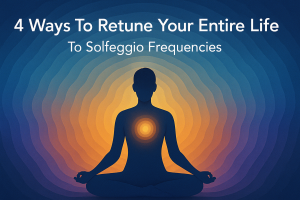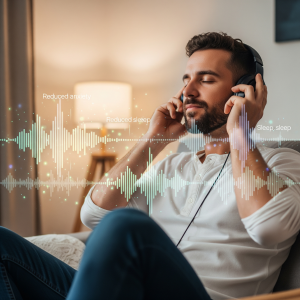If you have your finger on the pulse of wellness culture, natural healing, yoga and meditation, you’ve likely come across references to ‘sound healing’ or ‘sound baths.’ Proponents claim sound healing techniques can boost mood and overall health while reducing anxiety, depression, and even physical pain.
Sounds pretty amazing right? Well, as it turns out sounds ARE pretty amazing! If you’re interested in learning more about the benefits of sound healing, its origins, and how to begin a practice – we’re here to help.
What exactly is Sound Healing?
Most of us can attest to the fact that music has some sort of healing capability. Listening to sad songs when we go through breakups can help release stored emotions and allow us to process our grief. Similarly the right kind of uplifting jam coming on the radio while we’re stressed out sitting in rush hour can change our entire day around.
Practitioners of sound healing take this idea a few steps further. The theory surrounding sound healing is that the vibrations of different sound frequencies can enter our bodies and help restore energetic systems which elevates the body, mind, and spirit.
Sound Healing is a subtle practice that is very gentle and works on an energetic level. Meaning, you may not be cured overnight, but through incorporating healing sounds and meditations over time, practitioners believe you will notice a variety of benefits.
Where did Sound Healing originate?
Fascinatingly enough, Ancient cultures from around the globe all practiced different forms of sound healing. In fact, many archeologists and historians believe that music evolved simultaneously with Homo sapiens. That would mean that music and the use of sound is as old as our species. It is quite literally, part of us.
The oldest evidence of sound healing practices comes from ancient
Aboriginal cultures in what is now known as Australia. Elders and healers would use a wind instrument called the didgeridoo and play it nearby when people were sick or injured. The sounds and deep vibrations were believed to help heal all kinds of ailments. The earliest archeological evidence of these practices is many thousands of years old.

There is evidence of Ancient Egyptians using sound healing techniques as well, and some scholars believe that the pyramids themselves were designed for acoustic resonance to amplify sound healing during rituals and ceremonies.
Gregorian chants are said to be in resonance with the Solfeggio Frequencies, a popular modern day school of thought in the sound healing realm. Ancient Greek philosophers were the first to measure sound resonance and linked it to the cosmos as well as the human body.

One of the more popular forms of sound healing, and what comes to mind for many of us, are the singing bowls that originated with meditative practices of Tibetan Monks. This is only a taste of the many ways that ancient cultures used sound healing practices. As the practices change and grow in popularity today, many believe science is only beginning to catch up to the vast knowledge of the ancients.
Is there any evidence that backs up sound healing?
Over the past 20 years there have been several promising studies in the realm of sound healing and its benefits, but the research is still lacking and full of contradictions.
The holes in some of the sound healing theories create space for lots of new and exciting research, and many practitioners of sound healing are eager to see more independent studies and experiments – convinced that the evidence will continue to prove the healing powers of sound.
Evidence that proponents currently point to include a study on patients with fibromyalgia who experienced decreases in pain and were even able to decrease dosages of pain medication after engaging in sound healing practices.
Another promising area of research is in Psychology and Psychiatry. An entire area of clinical mental health treatment is now known as Music Therapy, and it has shown great benefits for people suffering from a variety of mental illnesses including anxiety, depression, and PTSD.
While more research is certainly needed, most agree that sound therapy can be a great addition to more traditional forms of treatment. If nothing else, music can definitely aid in mediation and relaxation which has all sorts of proven health benefits.
How to experience sound healing?

It’s easy to begin to experience sound healing, but it’s important to remember that you probably won’t be able to notice results overnight, although you will likely feel quite relaxed and uplifted after each session. Healers recommend trying out sound healing for around a month before evaluating whether or not it works for you.
Many yoga studios across the world may offer special sound ceremonies and events where you can try out sound healing techniques. The resources available on this website allow you to connect with some of the top sound healers from around the world for in person and remote healing sessions offering an easy and convenient way to experience the benefits of sound healing from the comfort of your own home.
Alternatively – a visit to a metaphysical store in your community will likely provide you with at least one healer that you can hire for a private ‘sound bath’ experience, in which they will play singing bowls made from metal alloy or quartz crystal aimed at balancing various energetic centers in the body. If in person sessions aren’t your style, there are plenty of online resources and ways to practice solo.
SYQEL, developed a state of the art music player called HZP, in which you can change all of the music in your music library to any of the Solfeggio Frequencies.
You can also find singing bowls at many different cultural shops or online, and there are many pre-recorded meditations that play various recorded healing frequencies available online. You can even tune in to some live events remotely. All you need is a dependable internet connection.
The future of sound healing
As the wellness culture continues to boom and alternative forms of healing and therapy rise, sound healing practices will almost certainly continue to grow in popularity.
Some famous musicians are recording entire songs in beneficial frequencies, and yoga studios are incorporating sound therapy into classes.
As more research is conducted, and confidence in the benefits of sound healing grows, it’s quite possible that you might soon see sound healing practices happening in schools and corporate workplaces, or as beneficial therapies alongside traditional western medicine.
Full disclosure – until there’s more research, it’s important to keep in mind that sound healing should not be used in place of the opinions of qualified healthcare professionals in both the mental and physical modalities. It’s best used as an additional treatment practice, never as a replacement, especially for serious physical and mental conditions.
That being said, sound healing and music therapy can be a great way to play with some of the healing techniques of the ancients and are almost completely risk free, unlike some other alternative healing techniques. You can begin whenever you want. Put on some comfy clothes, relax, and enjoy the healing power of sound.



